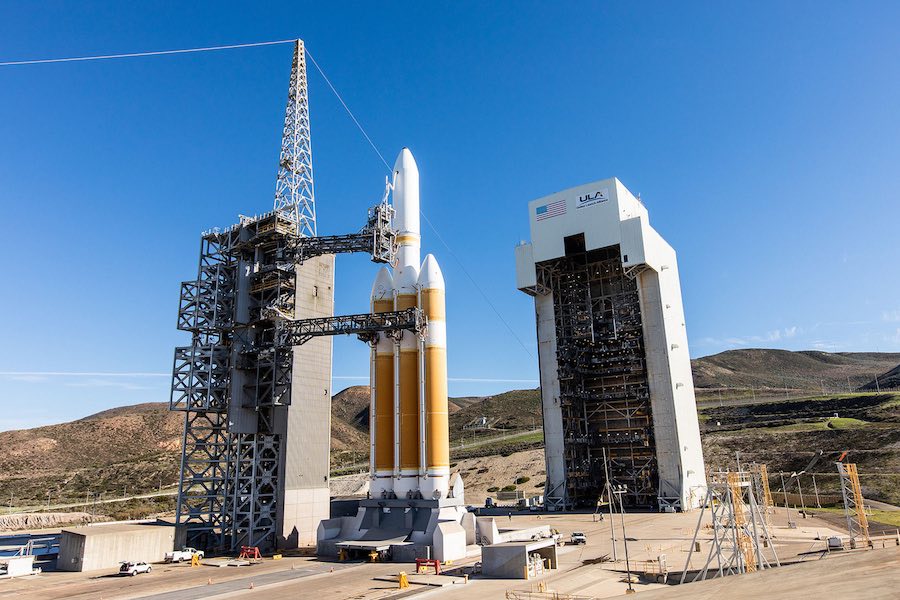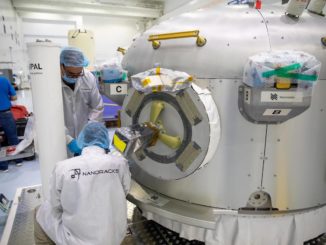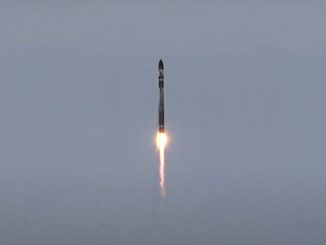
After unusual concentrations of hydrogen around the rocket foiled a launch attempt Dec. 19, United Launch Alliance said Friday that the company’s powerful Delta 4-Heavy launcher and a U.S. government spy satellite will remain grounded in California until at least Jan. 6 as engineers troubleshoot a small fuel leak.
ULA has tried to send the Delta 4-Heavy skyward four times since Dec. 7, but technical problems and unfavorable weather have kept the rocket on its launch pad at Vandenberg Air Force Base, California.
A top secret payload is fastened to the top of the Delta 4-Heavy for the National Reconnaissance Office, which owns the U.S. government’s surveillance and intelligence-gathering satellites. Analysts believe the spacecraft awaiting launch on the Delta 4-Heavy, whose mission is known only by the codename NROL-71, is likely a very high-resolution imaging satellite with an Earth-facing telescope built to collect sharp pictures of strategic sites, battlefields and other targets around the world.
The Delta 4 team called off a Dec. 7 launch attempt to investigate a glitch in the the holdfire system that would allow safety officers to abort a liftoff. On Dec. 8, the Delta 4’s automatic countdown sequencer halted the clock at T-minus 7.5 seconds, just before the rocket’s three RS-68A main engines were supposed to ignite.
Engineers blamed the Dec. 8 abort on “an intermittent signal from a bad monitor (that) caused an automated hold to be triggered,” wrote Tory Bruno, ULA’s chief executive, on Twitter.
ULA tried again to launch the Delta 4-Heavy rocket Dec. 18, but gusty winds thwarted that launch attempt.
Managers scrubbed the next try Dec. 19 after sensors detected elevated concentrations of hydrogen around the engine section on the launcher’s port-side booster after fueling the Delta 4-Heavy with cryogenic liquid propellants.
The Delta 4-Heavy was filled with around 465,000 gallons of super-cold liquid hydrogen and liquid oxygen to feed the rocket’s three Aerojet Rocketdyne RS-68A main engines, and an upper stage RL10 engine also made by Aerojet Rocketdyne. Sniffer sensors around the launch pad indicated higher-than-expected levels of hydrogen gas around the base of the rocket, prompting ULA’s launch team to postpone the launch in the final minutes of the countdown.
“Very small hydrogen leak,” Bruno tweeted Dec. 26. “Not dangerous in itself, but better safe than sorry.”
Standing 233 feet (71 meters) tall, the Delta 4-Heavy is the biggest rocket in ULA’s fleet of Atlas and Delta launchers. Fully fueled, the rocket weighs 1.6 million pounds and will be driven off the launch pad with 2.1 million pounds of thrust from its three main engines.

ULA initially aimed to try again to launch the Delta 4-Heavy as soon as Dec. 30, but the company said in a brief statement Sunday that the mission would be pushed back to no earlier than Jan. 6. The statement from ULA offered no details on the reason for the longer delay.
With the delay at Vandenberg, ULA will end 2018 with eight launches — five Atlas 5s, two Delta 4s and a Delta 2. ULA’s rockets blasted off from Cape Canaveral five times, and from Vandenberg three times this year, including the launches of two major NASA science missions — the InSight lander to Mars on May 5 on an Atlas 5 from California, and the Parker Solar Probe on Aug. 12 aboard a Delta 4-Heavy from Florida.
Based on the movement of the Delta 4-Heavy’s launch time each day — a launch window bounded by the orbit targeted by the rocket and its payload — liftoff on Jan. 6 is likely scheduled around 1:50 p.m. PST (4:50 p.m. EST; 2150 GMT).
A Falcon 9 rocket built and operated by ULA rival SpaceX was previously set for liftoff from a nearby launch pad at Vandenberg on Jan. 7 carrying 10 Iridium voice and data relay satellites, the last of a set of 75 upgraded commercial Iridium spacecraft launched by SpaceX since January 2017. Iridium CEO Matt Desch wrote Thursday on Twitter that the launch remained scheduled for Jan. 7 at 7:53 a.m. PST (10:53 a.m. EST; 1553 GMT).
The Air Force-run Western Range at Vandenberg typically requires a day or two to reconfigure safety and tracking assets between rockets, raising questions about whether the Falcon 9 launch was postponed, or if the Delta 4-Heavy on a national security mission might take priority over a commercial SpaceX launch.
In a subsequent tweet Friday after ULA’s announcement, Desch wrote that he has not heard of any delays in Iridium’s launch. The 10 satellites, built by Thales Alenia Space and Northrop Grumman, are at Vandenberg, fueled with maneuvering propellant, mated to their dispensers and encapsulated inside the Falcon 9’s payload shroud, Desch said.
The NROL-71 and Iridium missions will be the first launches of 2019 for ULA and SpaceX.
Email the author.
Follow Stephen Clark on Twitter: @StephenClark1.



